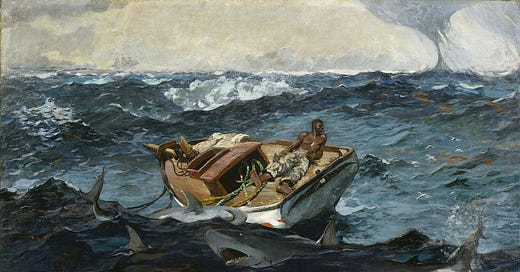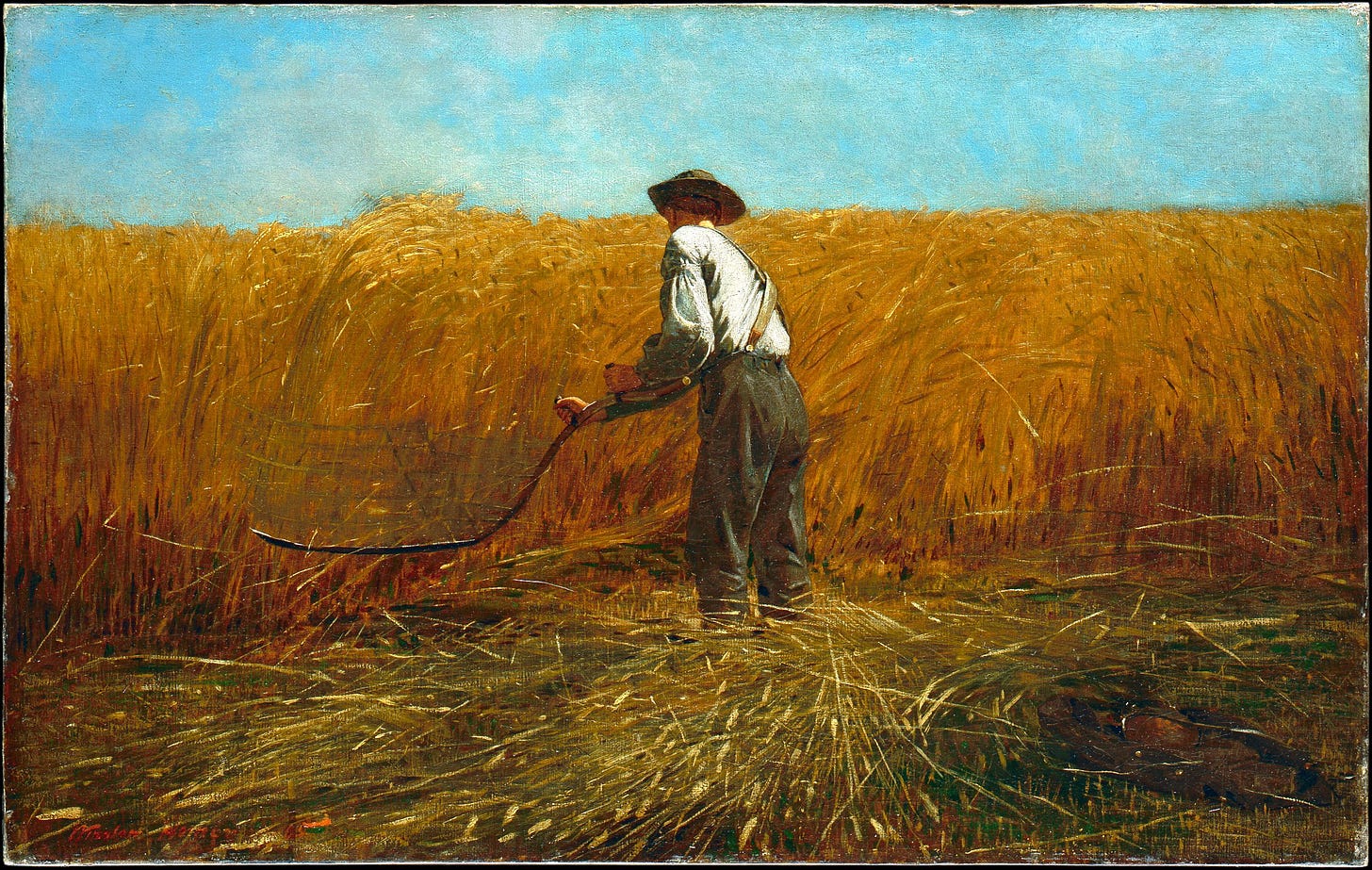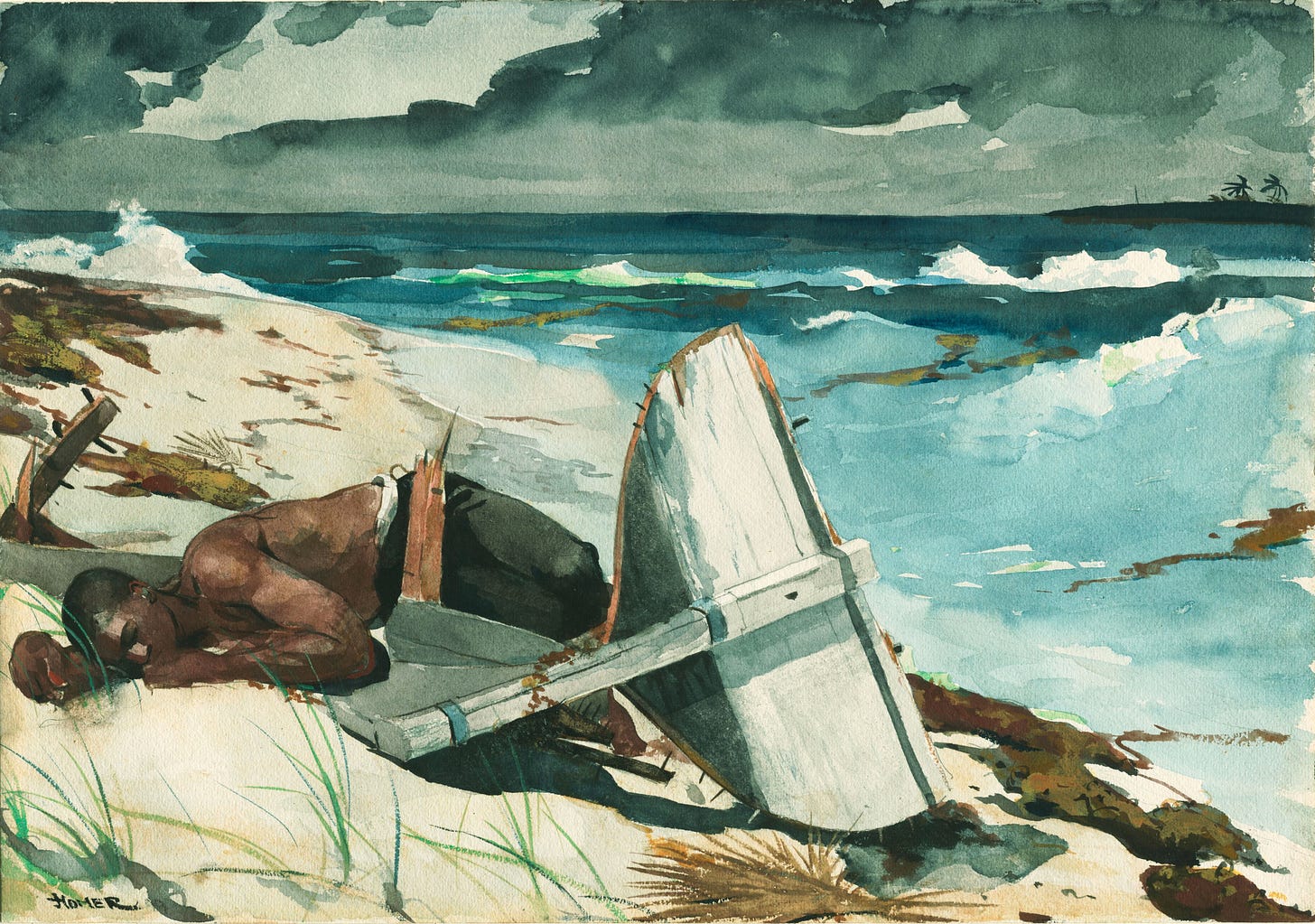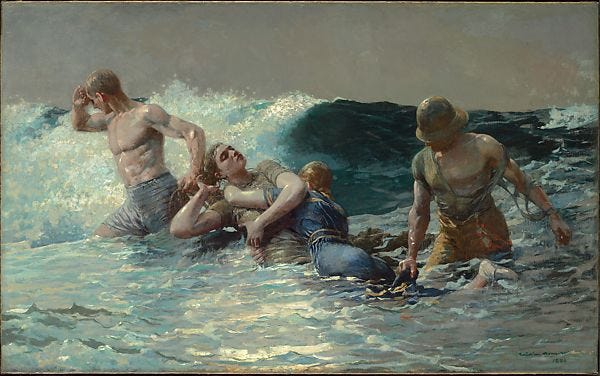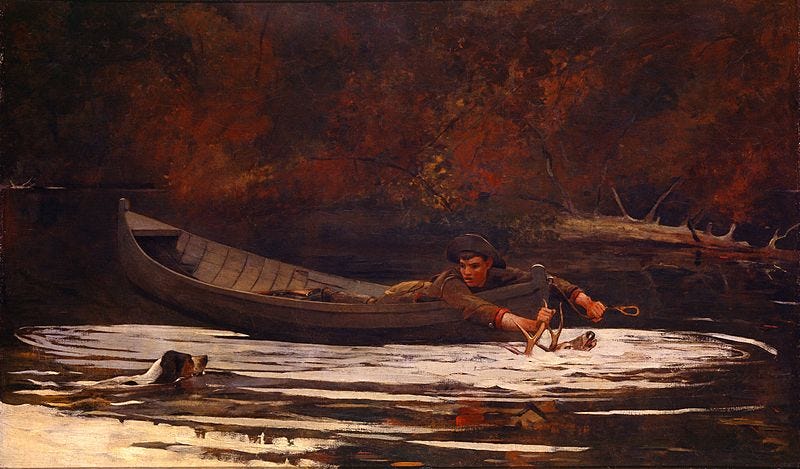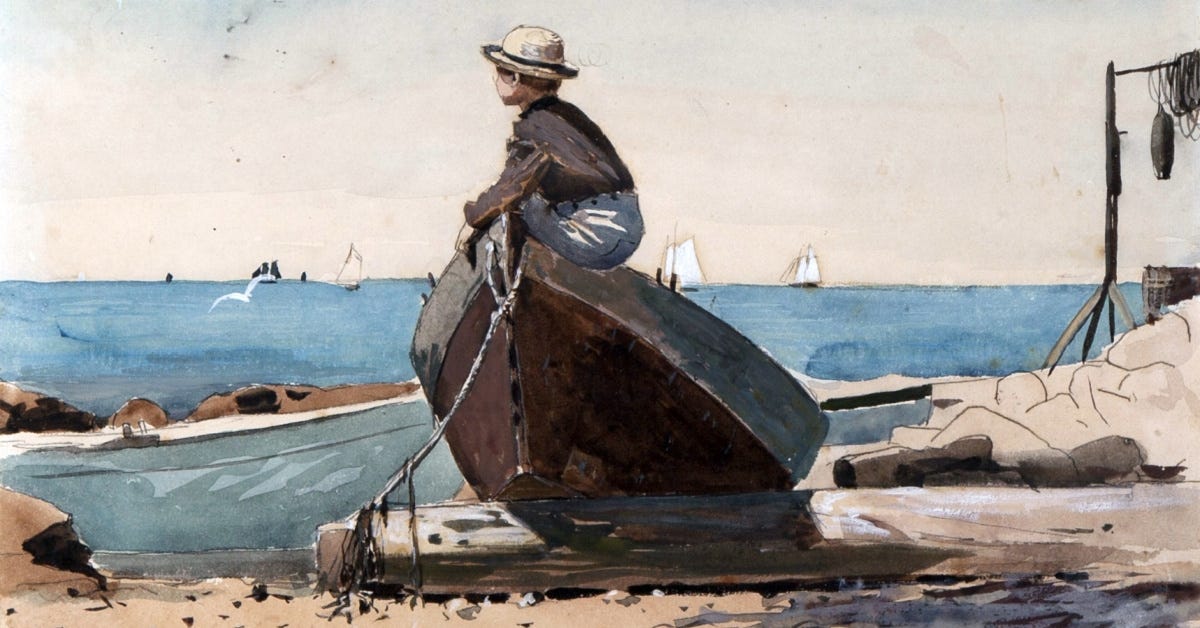The Met Museum has mounted a stunning new exhibit, aptly named Winslow Homer: Crosscurrents, which reconsiders Homer’s work through the lens of conflict, a theme that crosses his prolific career. Max Hollein, the Director of the Met, calls the show a “once in a lifetime opportunity” to experience the full breadth of Homer’s career. I couldn’t help thinking that the show, though beautifully curated, somehow missed the most important and obvious conflict Homer battled his entire life. Head up to the Met and take a look at the paintings for yourself. You won’t need me to point out the obvious. The conflict is there in nearly every picture.
The Gulf Stream, the title of the show and its inspiration, is the lynchpin for its argument that Homer was the first American artist to explore the issues of war, slavery and ……The Gulf Stream was one of the first Homer paintings acquired by the Met in 1906. Looking at the painting we see a lone black man on a damaged boat, adrift in a tempestuous sea, surrounded by sharks. Art historians have said that the painting represents the reconstruction of America, the lone black man facing the looming reality of a society unprepared for emancipation. The sharks represent the white world and its predatory leanings. The more things change, the more they stay the same. In the upper left corner, far off in the distance, is a white ship, we can only hope will save this man from a bloody death. While The Met’s curators discuss the beauty of this painting and the power and grace of the lone black figure, there is never a discussion of Homer the artist, and how he has come to render a black man so beautifully. Yes, he spent time in the south capturing the imagery of the Civil War as a form of reporting. But, the boy in The Gulf Stream alludes to a more intimate knowledge of the black male body. How can that be? Has Homer be in closer proximity to black men than watching them on the battlefield or in prisoner of war camps? And what about the adoration of this body? Doesn’t Homer point to an intimacy that could be described as love?
Winslow Homer was sent as a special artist correspondent by Harper’s Magazine to cover the Civil War in Virginia. There he became intimately acquainted with the horrors of war as well as the inhumanity of slavery. The veteran in a new field is one of Homer’s most famous paintings. It was painted in the spring of 1865 soon after the surrender by Lee at Appomattox and the assassination of Lincoln. The painting clearly pays homage to the soldiers who died and mourns the loss of Antebellum innocence. It is a nod to the past and a wink at the future. The southern soldiers who survived the war, return to their farms and are faced with reconstruction in a post-slavery economy. The beauty of the singular figure toiling away in a field, harvesting food for his family pulls on the heart-strings as we imagine the despair of war as it intersects with the hope of a new world. Homer, the ever-single man is there in the painting as well. Always toiling away at his never ending work, facing the world alone.
“I think it would probably kill me to have such a thing appear—and as the most interesting part of my life is of no concern to the public, I must decline to give you any particulars of it.” - Winslow Homer, regarding his love life to a biographer in 1908.
Homer met a black man named Lewis Wright in Boston in 1895 and soon after the meeting, asked him to move in with him in his Prout’s Neck home in Maine. Wright acted as a man-servant until Homer’s death in 1910. In the quote above, Homer explains to a biographer why his personal life and the fact that he remained a life-long bachelor is inconsequential and of no interest to anyone. You have to look at Homer’s life in the context of the times he lived. He was a contemporary of Oscar Wilde, who was imprisoned for gross indecency for having a relationship with another man in May of 1895. The trial and his imprisonment brought a screeching halt to Wilde’s brilliant career and practically buried his writing for eternity if it hadn’t been lovingly protected by one of Wilde’s boyfriends, Robbie Ross. It’s not hard to see why Homer would remain closeted in such a homophobic, sadistic and inhumane Victorian society. where exposing one’s same-sex desires risked career and even one’s life.
To escape the harsh Maine winters, Homer and Wright travelled to the Bahamas. It is there that the painter observed and captured the day-to-day activities of island life in his beautiful watercolors, some of the most beautiful paintings in the exhibit and what would become his bread and butter. In The Turtle Pound, two young athletic black boys work at capturing turtles to sell at the local market. Here Homer exposes the vulnerable soft underbelly of a white turtle beneath the gazing eyes of a handsome black boy. It’s right there in black and white. Who is the top and who is the bottom?
Art historians argue that Homer was married to his work. Because he left no diaries and no documentation of his personal life, there can’t be any evidence of homosexuality. They choose to make him asexual rather than entertain the possibility that he might have been gay. It is just to scary to think that one of the foremost painters of Americana could possibly be gay. Instead they do some sort of heterosplaining that drains the sex drive from him altogether. If I were a betting man, I would place all my money on the idea that The Met’s curatorial team had at least one discussion in their planning meetings about whether to address Homer’s sexuality and someone sitting around the table made the clear decision that it was “safer” to steer clear of the issue. Instead, the tip toe right up to the edge of the cliff and then back away. Once that decision was made, a sort of homonesia sets in and all discussions about his sexuality evaporate. Regardless, the exhibit is successful in it’s scope and congratulations are in order to the team for organizing Homer’s most iconic works of art in one place, many from all the major art institutions around the world. There is a lost opportunity here, though. Can you imagine curating a show of Picasso’s work without even a mention of the fact that he loved women? In this once in a lifetime opportunity we miss out, as another exhibit of this scope won’t happen again anytime soon. Perhaps the next generation will be brave enough to look beneath the surface and discover Homer’s real motivation, or perhaps it won’t even matter anymore.
Regardless, Homer’s sexuality is there in every picture. I am reminded of the controversy regarding Robert Mapplethorpe’s work in the late eighties. Senator Jesse Helms and other conservatives got their panties in a dither over the sexual content of Mapplethorpe’s work. Or rather they could tolerate the overtly homosexual nature of his work. In a hearing on the senate floor, arguing to defund the National Endowment for the Arts because of their support of a Mapplethorpe exhibit, Helms in a fiery speech said,
“Any senator that thinks that I am attacking aesthetic art, if they have any doubt, then look at the pictures. Look at the pictures. Look at the pictures.” - Jesse Helms in the US Senate, 1989, arguing to defund the NEA in response to an exhibit of Robert Mapplethorpe’s work.
You can see all Mapplethorpe’s photos here.
Which brings me to the question of why? Why is a discussion of Homer’s sexuality important? At a time when the State of Florida has passed a law saying “Don’t say gay” in the classroom because they fear it exposes children to the gay lifestyle, here in New York, The Met “won’t say gay” for the very same reason. It’s still just to scary to accept that homosexuality is part of human sexuality. It is a natural as any other form of sexuality. I am reminded of Oscar Wilde’s quote in his indecency trial where he calls homosexuality the love that dare not speak it’s name.
It is in this century misunderstood, so much misunderstood that it may be described as the"Love that dare not speak its name," and on account of it I am placed where I am now. It is beautiful, it is fine, it is the noblest form of affection. There is nothing unnatural about it. It is intellectual, and it repeatedly exists between an elder and a younger man, when the elder man has intellect, and the younger man has all the joy, hope and glamour of life before him. That it should be so, the world does not understand. The world mocks at it and sometimes puts one in the pillory for it."
- Oscar Wilde at his gross indecency trial, 1895.
The HOmer exhibit is up at The Met through July 31st. Go luxuriate in the sumptuous beauty of Homer’s paintings. Contemplate his musings on race and class and all of the political issues of the Victorian era. Look at the pictures, look t the pictures, look at the pictures. But, whatever you do, don’t say gay.
Can’t make it to NYC this summer? Take the virtual tour.
Join curators Stephanie Herdrich and Sylvia Yount for a virtual tour of Winslow Homer: Crosscurrents, which reconsiders Homer’s work through the lens of conflict, a theme that crosses his prolific career.

